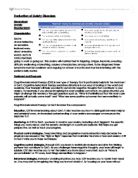In to the explanations of PTSD, the psychological model can provide an assumption under the Behavioural, Cognitive and Psychodynamic view.
The Behaviourists believe that PTSD may have something to do with Classical Conditioning where PTSD is possibly learnt. To show more clearly how this works, Pavlov 1927, presented dogs with a fear factor. This stimulus was then associated with environmental cues, which became the conditioned stimuli. The dogs then presented fear to the conditioned stimuli. In relation to humans, the conditioned stimuli present at the time of the traumatic event, causes the fear reaction. For example, in shell shock, similar noises to that of weapons can be related to it and so that causes anxiety.
In conjunction with the Behaviourists, the Cognitives agree that what ever is experienced along side the traumatic event, will bring back the full memory of it. These include sight, smell, feeling and sound. As with the Behaviourists, Cognitives believe that sufferers may feel that they are no longer in control of their lives and think irrationally about how they were the cause of the incidents. Due to these thoughts, the symptoms of drinking, drug usage and detachment from others may result.
However, inadequate coping strategies of alcohol abuse, drugs ect. Could fail to reduce the effect of trauma and increase stress that leads to PTSD instead (Lazarus 1991). The Cognitive also do not agree on the behavioural idea that classical conditioning is the only mechanism responsible for PTSD, as not everyone that experiences traumatic events develops the disorder. Green 1994 supports this and reports that PTSD develops in approximately 25% of those that experience traumatic events. Also the range is quite large at 12% for accidents and 80% for rape.
There are also individual differences to the degree of recovery before PTSD is reached as people have various revival rates. The environment can also play a part in recovery due to the accessibility of social support. Hunt 1997 found that support systems helped amongst the Normandy veterans. Comradeship was still important and assisted war traumas. Bender 1995 has also approved social support. Bender suggests that people must process their traumatic experiences instead of objecting them and integrate them into worldviews. By thinking about the traumatic events, it would lead to extinction of the responses associated with it.
For further explanations of factors affecting the development and maintenance of PTSD, Dunmore 1999 explains. In assault victims, factors of PTSD’s onset were investigated and compared with non-PTSD sufferers. The onset factors were found to include detachment during assault and failure to perceive positive responses from others. For factors related to the maintenance of PTSD, PTSD suffers and PTSD recovers were compared. The results included appraisal of aspects of the assault itself (e.g. mental confusion), appraisal of what came after the assault (e.g. negative responses from others), dysfunctional strategies (e.g. avoidance) and beliefs impacted by the assault. Based on all these factors, recovery may be prevented and the nature of the traumatic memory may be affected.
Psychodynamics believe that maybe the past has effect on the vulnerability to PTSD. It could be that childhood abuse may cause the person to psychologically dissociate themselves from experience and memories of abuse. This may become a habitual way of dealing with other events. Comer 1998 says ‘thus setting the stage for the development of an acute or Post Traumatic Stress Disorder’. This view has been challenged, as there isn’t any evidence for this and seems an un-recallable subject for PTSD sufferers. In which case, child abuse could easily make people stronger against anxiety disorders.
Freud also added that many neurotic disorders occur because of the inability for people to remember bad experiences. However, this is very untrue for PTSD sufferers, as they cannot rid the vivid memories of their traumatic experiences.
In a case of PTSD, her manager had raped Susan who was 23 years of age and a clerical worker. Her reactions to it was to ‘scrub away the effects of the rape’ in the shower. She had the predicted symptoms of becoming distant and un-sociable. She lost concentration on her work, was emotional and easily startled. After Susan saw a counsellor six months later, she revealed for the first time that she had been raped. She felt cheap and filthy and even began to think maybe she had ‘asked for it’. Susan managed to continue with her life for over two months but later reported to having nightmares and intrusive images of violence.
According to the Cognitive, Susan should have acquired social support instead of keeping her experience a secret. Bender also suggested that people should process their traumatic experience in order to clear the responses associated with it. Her loss of concentration at work could be due to the Classical Conditioning of associating work with rape.
There is evidence for the Behavioural suggestion of Classical Conditioning and the Cognitive view to the cause of the onset and maintenance of PTSD. For example, Pavlov’s 1927 dog study, and Dunmore’s 1999 comparison of PTSD sufferers. Social support has also been proved to be a positive practice by psychologists such as Hunt 1997. However, Puttnam 1996 feels that there are individual differences to recovery rates from traumatic events. The Psychodynamic idea of the past possibly effecting a persons vulnerability to PTSD cannot be proved. Therefore, whether abused children should be stronger or more prone to PTSD is left theoretical. Even interviews with patients will not be reliable for answers.








